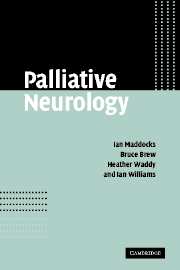Book contents
- Frontmatter
- Contents
- Foreword
- Note on drugs and abbreviations
- Section I Palliative Management
- 1 Introduction to palliation
- 2 Characteristics of palliation
- 3 Nodal points in decision-making
- 4 Common deficiencies in palliative management
- 5 Common themes in palliation practice
- Section II Major discomforts in advanced neurological illness
- Section III Major neurological conditions requiring palliation
- Section IV Ethical issues
- Section V Appendices
- Index
3 - Nodal points in decision-making
from Section I - Palliative Management
Published online by Cambridge University Press: 08 January 2010
- Frontmatter
- Contents
- Foreword
- Note on drugs and abbreviations
- Section I Palliative Management
- 1 Introduction to palliation
- 2 Characteristics of palliation
- 3 Nodal points in decision-making
- 4 Common deficiencies in palliative management
- 5 Common themes in palliation practice
- Section II Major discomforts in advanced neurological illness
- Section III Major neurological conditions requiring palliation
- Section IV Ethical issues
- Section V Appendices
- Index
Summary
INTRODUCING A PALLIATIVE MANAGEMENT APPROACH
(Figure 1.3.1, Point 1)
For incurable neurological diseases, palliative management offers an amelioration of discomfort, an avoidance of complications and a possible extension of life. It should be emphasized, however, that the diagnosis of an ‘obstinate’ or incurable condition must be firmly established before introducing patient and family to palliative or end stage care.
Once the clinical situation is clear, it is desirable that patient and family be introduced to its reality soon after diagnosis, along with a clear exposition of what can be done to maintain the best possible quality of life. Far from offering a message that ‘nothing can be done’, the neurologist tries to provide a positive view of the many supports that can help make life worthwhile. That is the essence of palliation.
The clinician may sketch out a future clinical pathway, sometimes called a coordinated care plan, one that emphasizes the several contributions to care that will be desirable or essential to ensure comfort and best possible function. The future clinical pathway will consider these components:
Therapies that can slow or modify unwelcome changes and assist function.
Site(s) of care that will best suit the patient and family.
A list of the persons who can assist in care, their roles and contact details.
Equipment appropriate to patient need, site and carer abilities.
Information and training in knowledge and skills needed by carers.
Medications that may reduce discomforts.
…
- Type
- Chapter
- Information
- Palliative Neurology , pp. 20 - 24Publisher: Cambridge University PressPrint publication year: 2005



